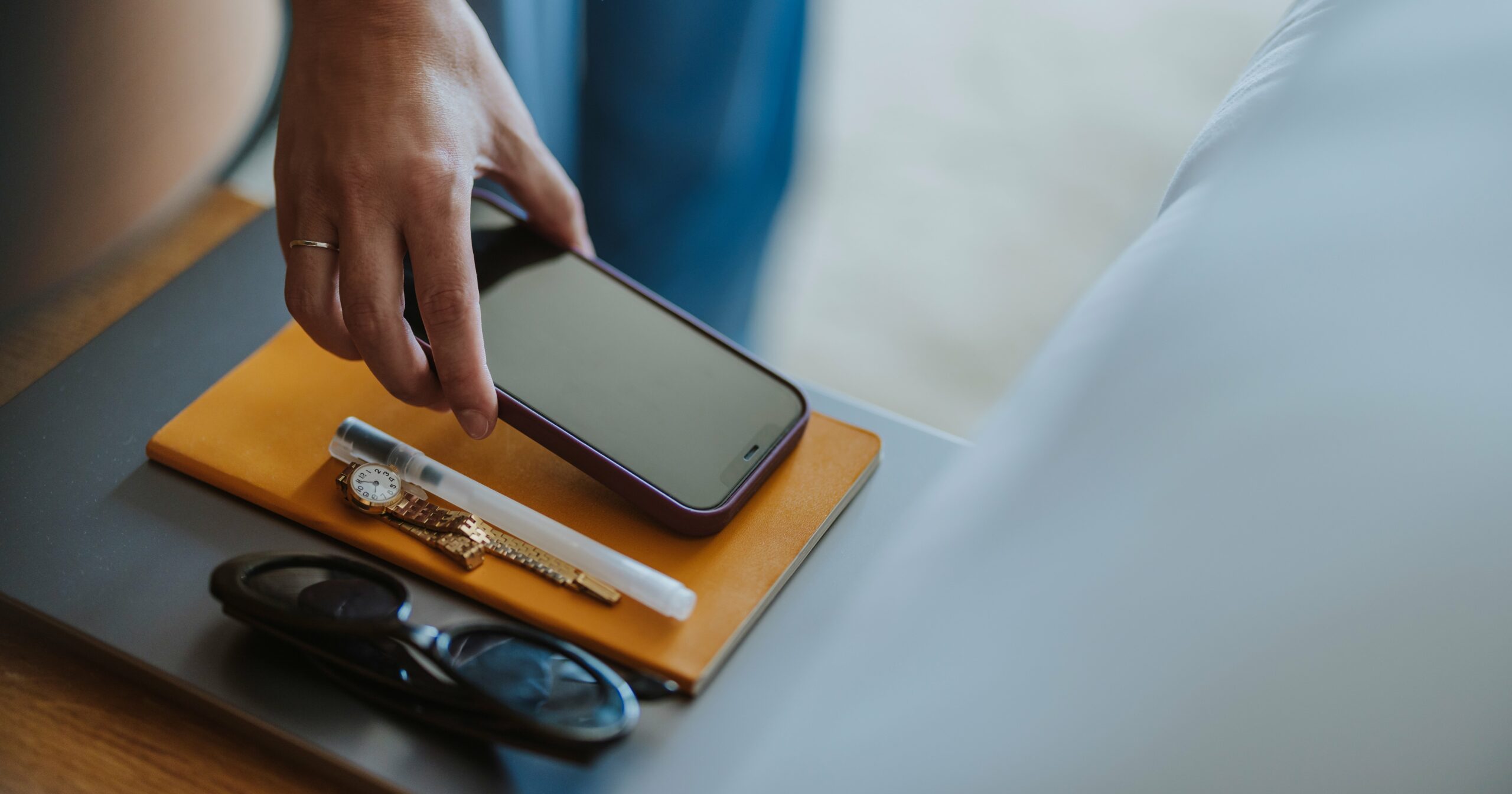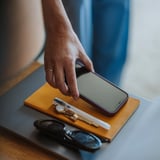With my body cocooned in a comforter and my head nestled on a pillow, I thumb my screen, endlessly scrolling social media until my eyes feel heavy and I fall asleep. In what feels like mere moments, my alarm blares, and I instinctively reach for my phone, checking my email before my eyes have even adjusted to the morning light. Scroll to sleep, wake to notifications, and repeat.
Over the last few years, this digital Groundhog Day slowly, maliciously became my reality – and I know I’m not the only one. Most of us are tethered to our phones for entertainment, work, or the hope of escapism. While I won’t sit here, typing away on my computer, and chastise anyone’s habits or choices – for me, I knew I needed to break this holding pattern. And I tried to.
As a health and lifestyle journalist, I’ve spoken to sleep experts about the importance of putting away screens before bed, and chatted with neuroscientists about all the ways social media can mess with our brain chemistry. After writing about all these pieces of expert-backed advice, I began dabbling with the best practices. I put my phone in the other room at night to charge, and prioritized reading before bed. And yet, it was all too easy to fall back into old patterns, especially if I was particularly inundated with work or simply too drained to self-regulate.
“My self-imposed challenge: Stay away from screens from 9 p.m. to 9 a.m.”
However, I recently remembered an article I’d read about a founder who intentionally kept her phone on airplane mode for one hour (sometimes even two) after she woke up. In that time, rather than scrolling or checking email, she meditated, exercised, and journaled – essentially, she engaged in activities that supported her well-being, and set her up for a more calm, successful day.
While reading that story, I was inspired to approach my day in a similar manner, with intention and respect for my own headspace. So, I set out to apply this rule to my morning. My self-imposed challenge: Stay away from screens from 9 p.m. to 9 a.m. Similar to intermittent fasting, when you only eat during a certain block of time during the day, I would apply the same structure with screens – intermittent digital fasting, if you will.
Experts Featured in This Article:
Rebecca Skolnick, PhD, is a licensed clinical psychologist and co-founder of MindWell NYC.
What Are the Potential Benefits of Intermittent Digital Fasting?
All of us, instinctively, know that too much time on our screens is inherently unhealthy. But what is it about the evenings and mornings that are particularly sensitive? For one, staring at light before bed (especially blue light) can “confuse your body into thinking it’s still daytime and can keep your brain active,” says Rebecca Skolnick, PhD, licensed clinical psychologist and co-founder of MindWell NYC, adding that this can disrupt our natural sleep-wake cycle and make it harder to fall asleep and stay asleep. “It is especially helpful not to ‘doomscroll‘ or take in a lot of information right before bed so your mind can start to unwind and not try to process so much incoming information,” she says. What’s more, you’ve probably heard it’s best to keep your laptop out of your bed – and the same goes for your phone, because it’s ideal to associate your bed with sleep, not “daytime activities.”
As for the morning, what you choose to do upon waking can really set the tone for the rest of your day. “Once you start looking at screens, you are giving your brain a lot of information and stimulation. Some of the information could be negative, anxiety-provoking, or stressful,” says Skolnick. “It is important to give your mind a chance to wake up naturally and transition into the day.”
What’s more, promptly checking social media may even wreak havoc on your brain activity. Research suggests that it forces the brain from a sleep state to a focused concentration state. In turn, the brain bypasses the sleepy dream-like state, and the awake yet relaxed states that usually come before concentration, explains neuroscientist Nicole Vignola in her Substack. “This primes your brain to be distracted throughout the day and can activate your stress response.” That’s true for a number of reasons – not only does it disrupt your natural sleep-wake cycle and create a heightened start to the day, but it also potentially elevates your dopamine baselines, causing you to crave stimuli (like, ahem, your phone) even more throughout the day to maintain that same level of stimulation. In other words, it starts your day on a pretty unpleasant note, which can have a ripple effect on your mood and concentration.
Skolnick suggests giving yourself at least a 30 to 60 minute buffer before bed and after waking so the brain has time to wind down or acclimate to the day.
As alternatives to screen time, she suggests taking a hot shower or bath, reading a book (off a device), listening to calm music or a soothing podcast, putting on comfortable clothes, gentle stretching, relaxation exercises, and meditation or mindfulness exercises.
My Experience With Intermittent Digital Fasting
In an ideal world, my bedtime is 10 p.m. and I wake up by 7 a.m., giving my body time to doze off and get a guaranteed 8 hours of sleep. Granted, that’s not always feasible (maybe I’m having a Friday movie night or writing into later hours), but I decided to create the challenge for myself based on this timeframe. So, my intermittent digital fasting window would be 9 p.m. to 9 a.m. – simple enough to remember, yet shockingly challenging to practice.
I am a bit embarrassed to admit how difficult it was to stick to this schedule. I would have one successful day, and then something would totally derail my plan the next. Still, eventually I was able to reach nearly a week of consistent intermittent digital fasting – and honestly, it did make a noticeable difference.
To set myself up for success, I leveraged a trick I’d dabbled with in the past: Moving my phone out of sight, out of mind. As part of my nighttime routine, I plugged my phone into its charger in a different room, so I wouldn’t feel tempted to mindlessly grab it. From there, without my phone to distract me, I moved through a slow wind-down ritual: I completed all my skincare steps, brushed my teeth, and cozied up with a book in bed. Rather than use my phone as a wake-up alarm, I actually used the Loftie clock that I invested in months ago for this very purpose (what a concept) – opting to wake to the sound of ocean waves.
In the morning (after, admittedly, hitting snooze a few times), I reached for my journal, and scrawled a couple pages. I completed my morning skincare routine. I went for a short morning walk with my husband, allowing the sun to be the first bright light of the day, rather than a screen. I ate breakfast. I enjoyed a soothing shower. On some days, I exercised in the morning, occasionally I took a cold plunge, and on other mornings, I meditated for a few minutes. Not every day looked the same, but there was one constant: I kept my phone out of sight until the clock struck 9 a.m.
Now, to be completely honest, as blissful as this may sound – the first couple of days were rough. I still woke up feeling a small pang of anxiety, like I was forgetting something. But as the days progressed, that feeling eased slightly – I reminded myself that the emails and notifications weren’t going anywhere. And if there was truly an emergency, someone would call my husband (yes, this isn’t exactly setting him up for his own screen-time-free setup, but that’s another story). This was truly an exercise in letting go, in more ways than one.
Beyond waking up more peacefully, I also noticed that I was significantly more focused when I didn’t start my day with screen stimulation. I felt more productive, and found I wasn’t reaching for my phone as regularly. This was especially apparent when I went from a period of time practicing intermittent digital fasting, then back to a day of checking my phone first thing – in the latter scenario, I was more scattered, with a steady stream of stress coursing through me. The contrast was both illuminating, and disturbing.
The Takeaway
After experimenting with intermittent digital fasting, I can confidently say this is a practice I will do my best to make a constant in my life. After reporting on the benefits of a wind-down routine, a slow morning, and generally minimizing screen time for years – this was the first time I really felt a major impact on my own mental well-being.
Realistically, I may not practice this every single day – especially not for a 12-hour chunk of time. That said, I am going to be much more mindful about delaying screen time in the morning (even if it’s just 30 minutes) and honoring my bedtime ritual at night.
This challenge may have started as a way to prove to myself that I’m not as reliant on tech as I think, and that my willpower is strong – but what I’ve come to realize is that isn’t the point at all. Instead, I view digital fasting as a deep and profound respect for myself, my energy, and my time. We only get so many hours in this lifetime, and I personally want to spend more of mine doing things that light me up.
So, while there’s nothing wrong with taking time to scroll – it can be a great way to connect with others, and even spark creativity, after all – I encourage you to set aside some time each day to exist in a world beyond tech. Spend a few waking hours that are purely yours, and perhaps begin to break any cycle that’s holding you back.
Kristine Thomason is a lifestyle writer and editor based in Southern California. Previously, she was the health and fitness director at mindbodygreen, and the fitness and wellness editor at Women’s Health. Kristine’s work has also appeared in PS, Travel + Leisure, Men’s Health, Health, and Refinery29, among others.



